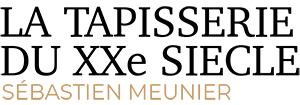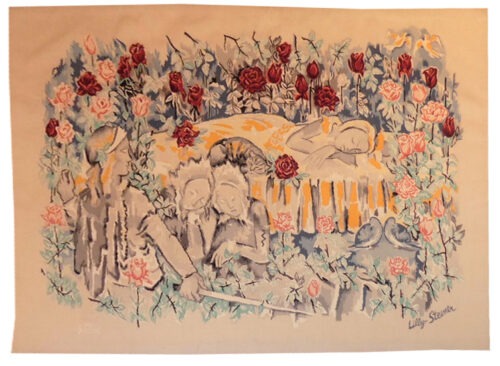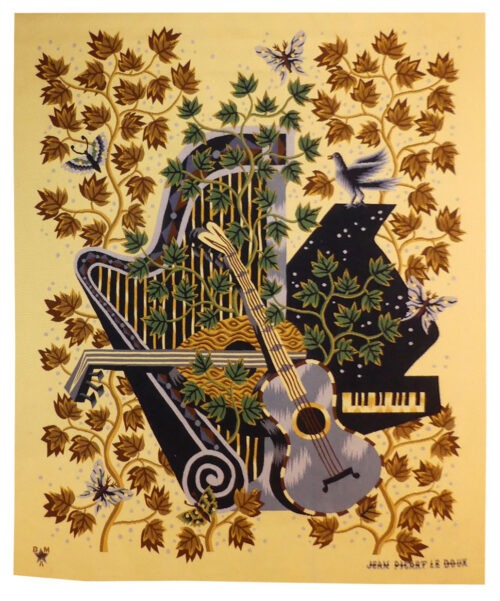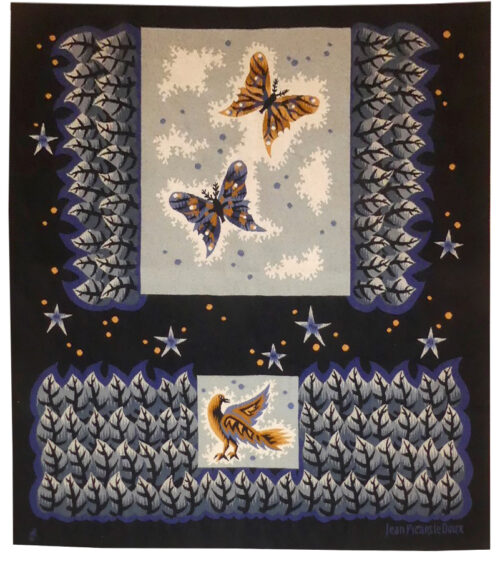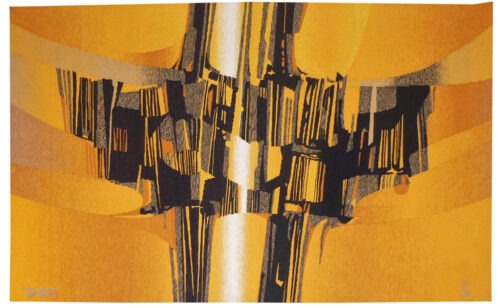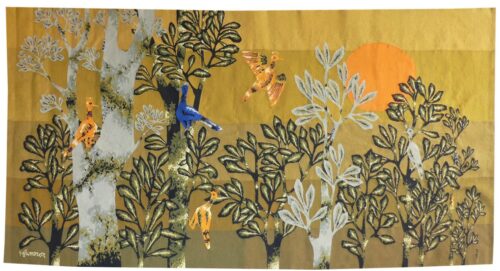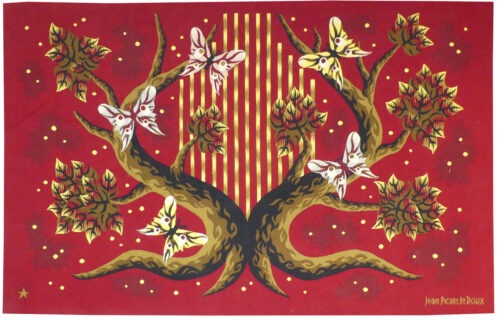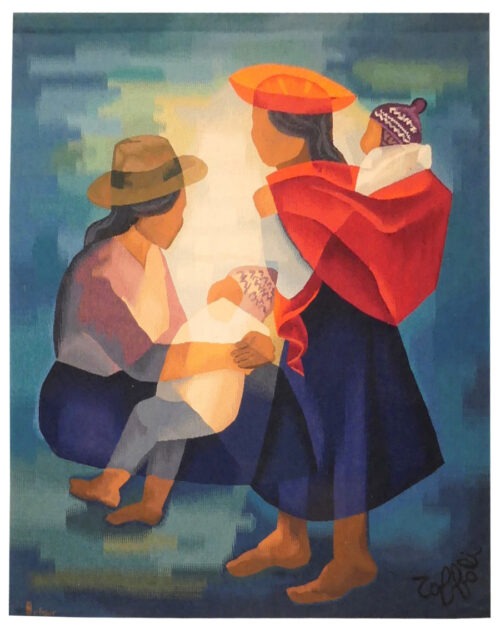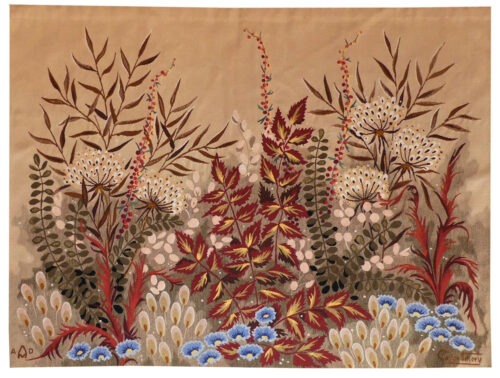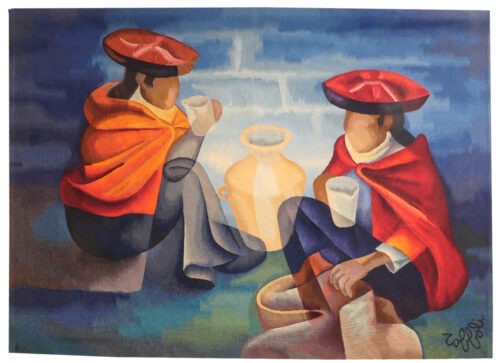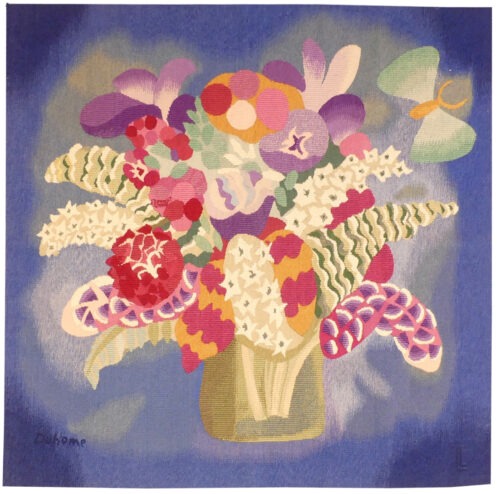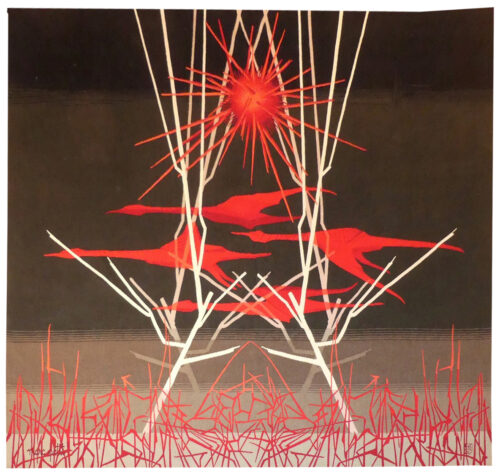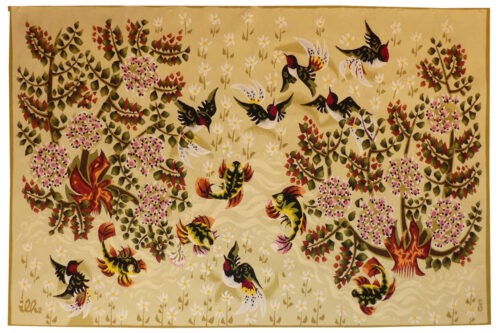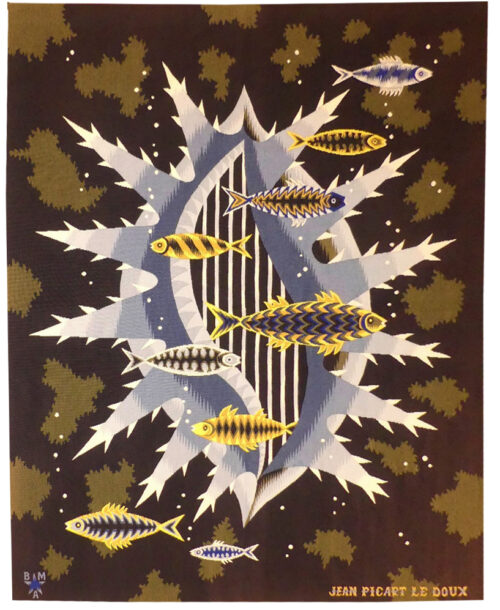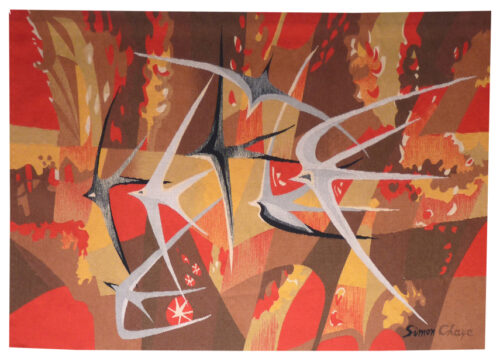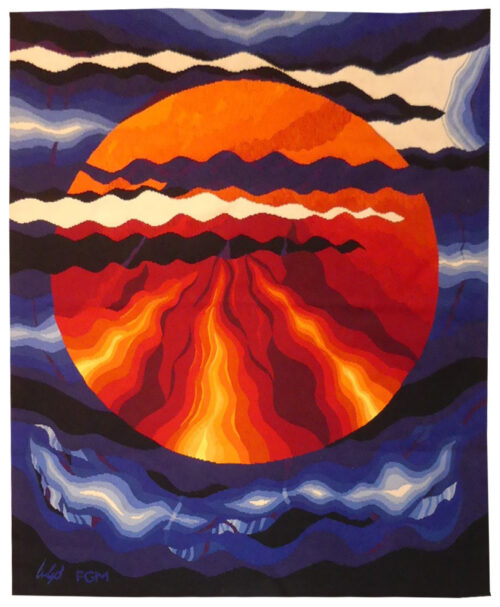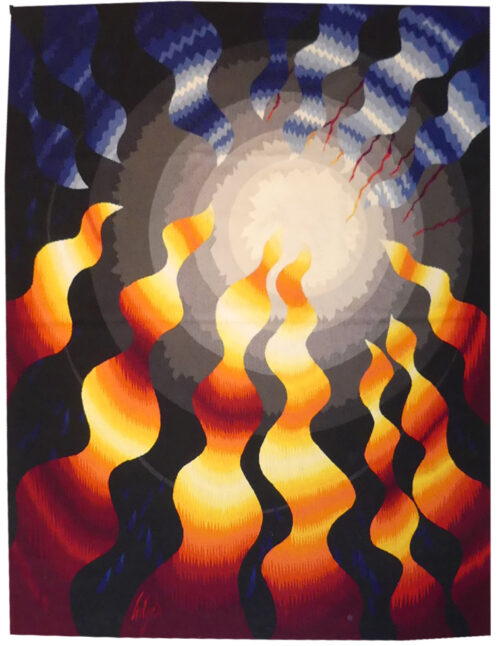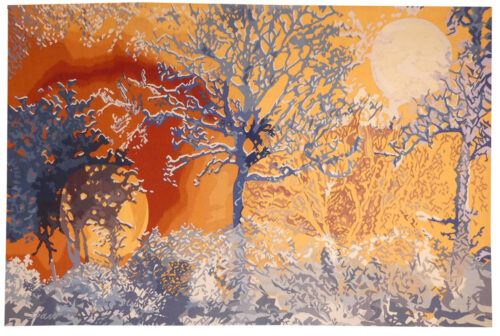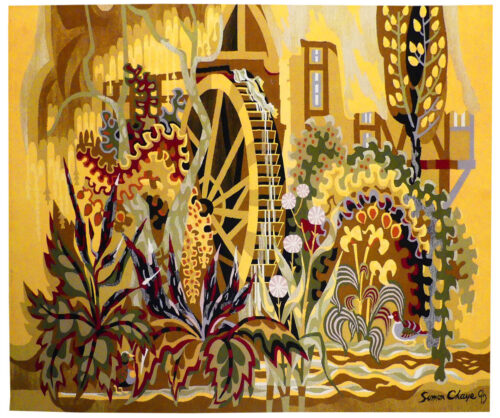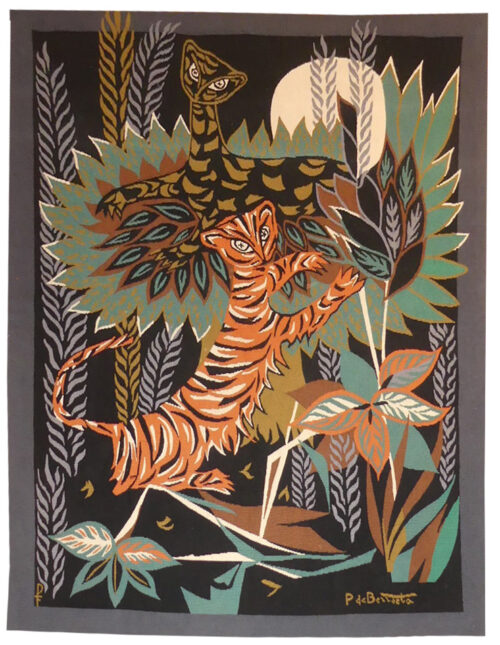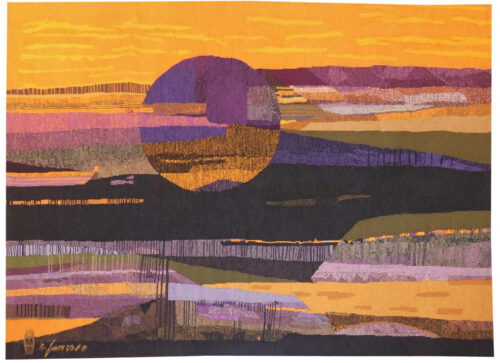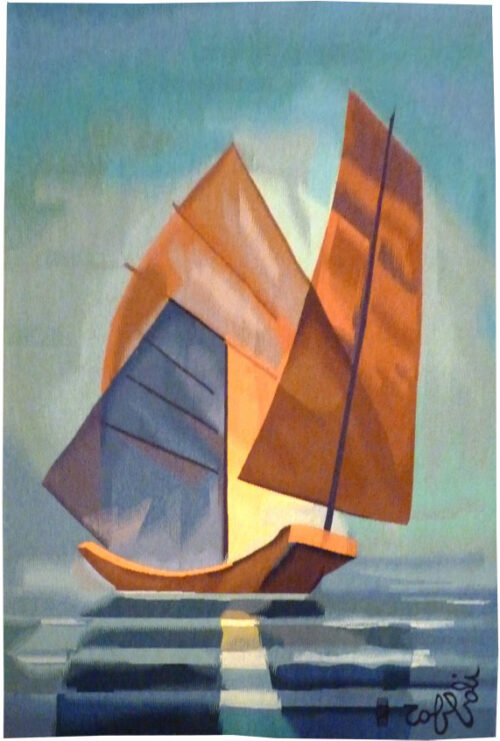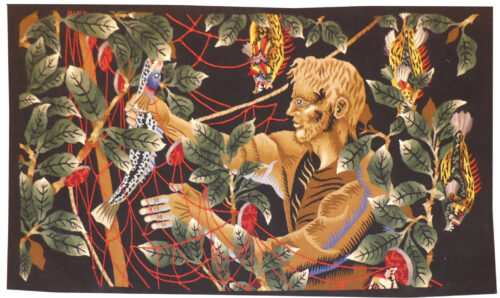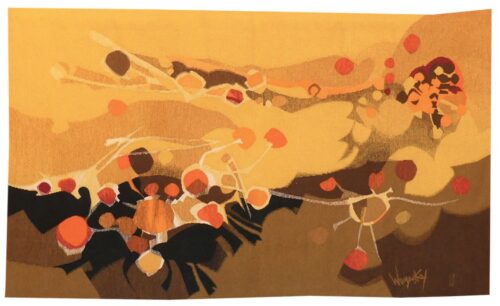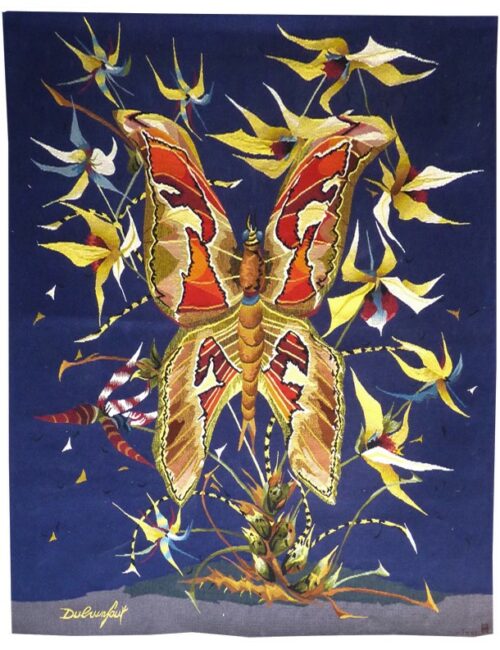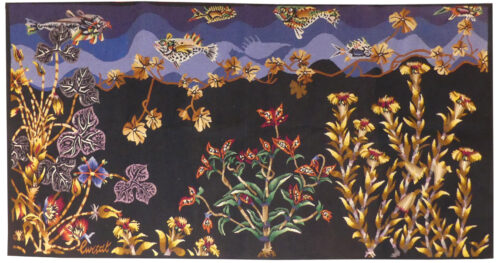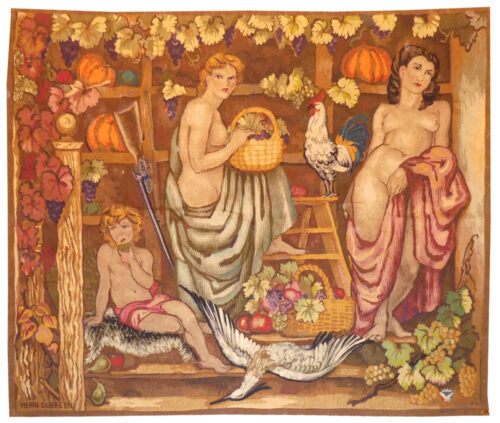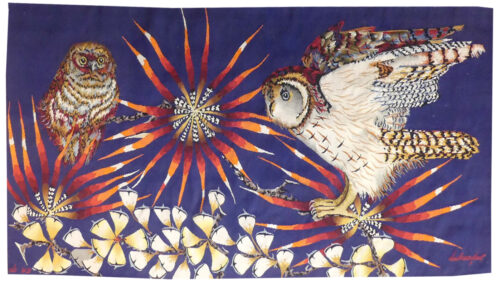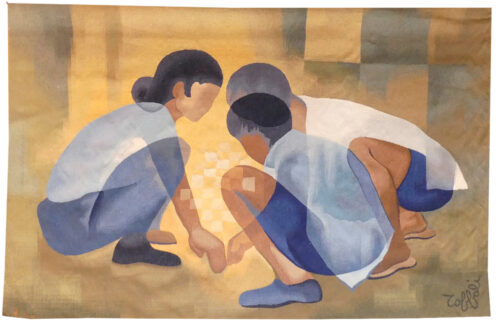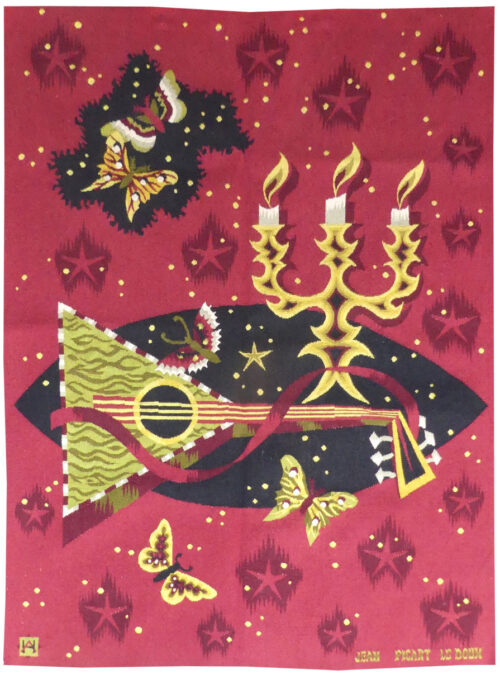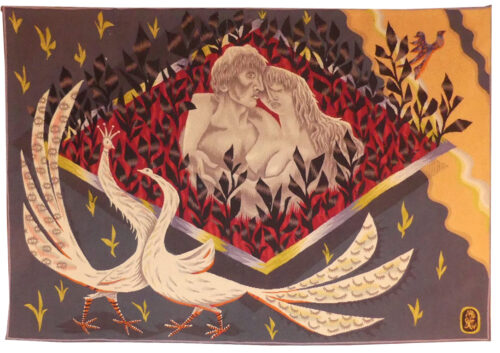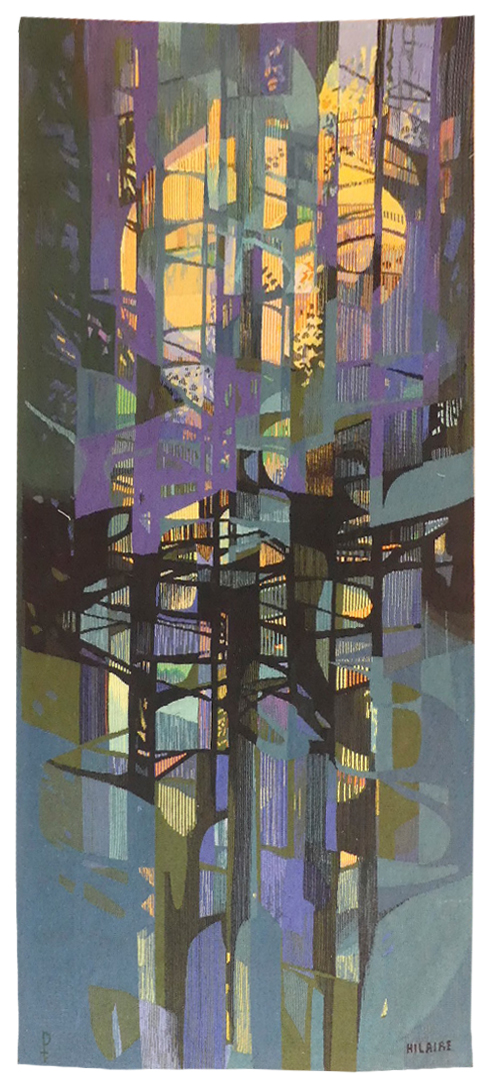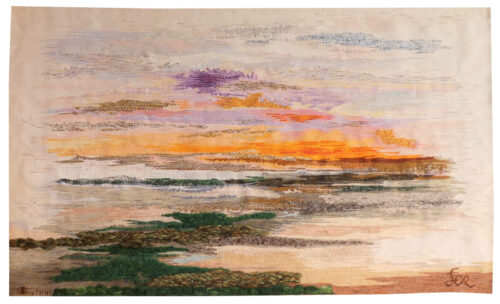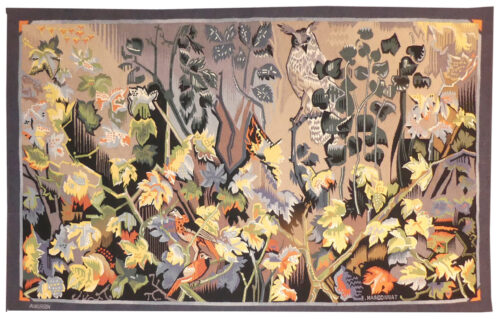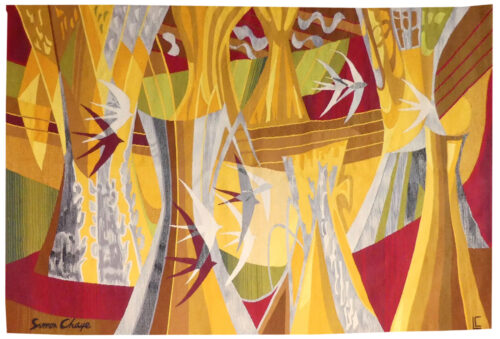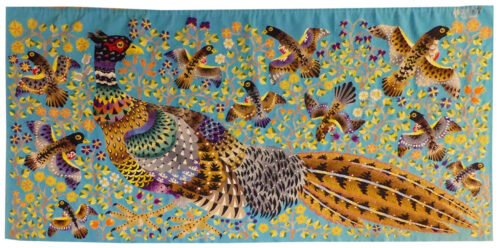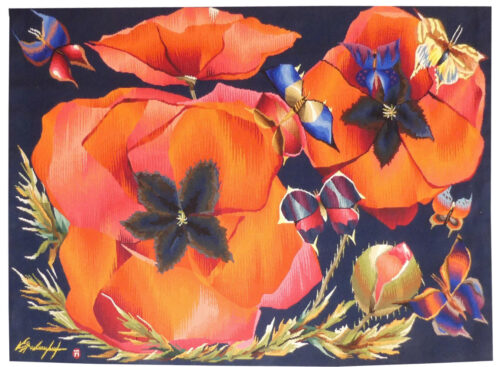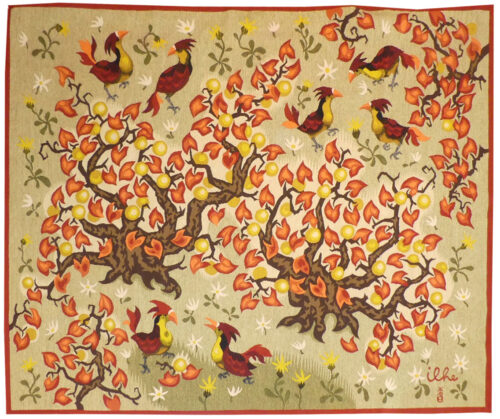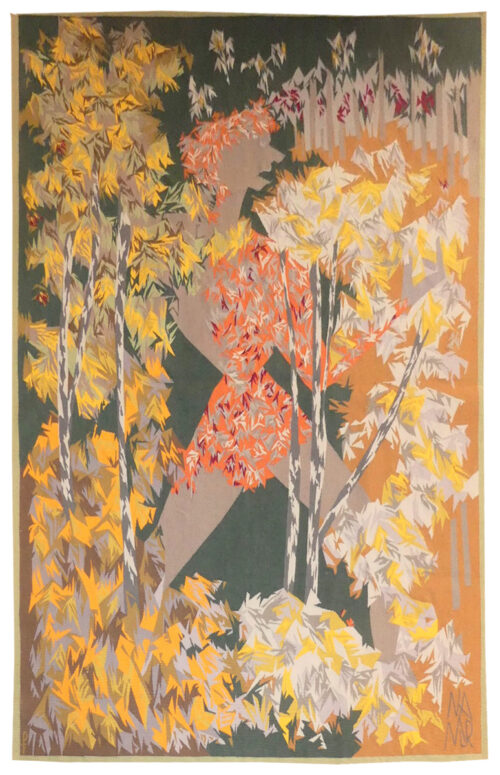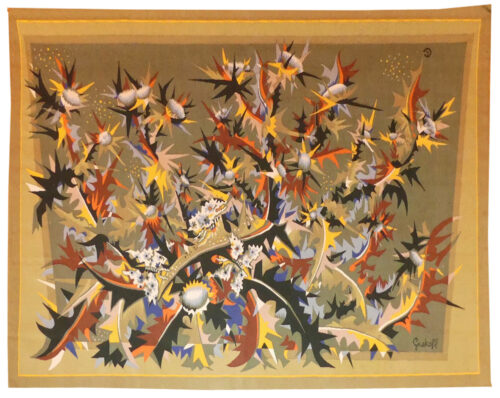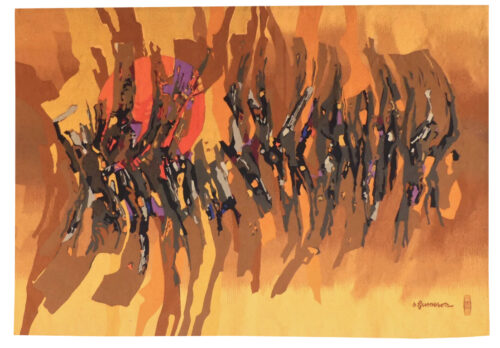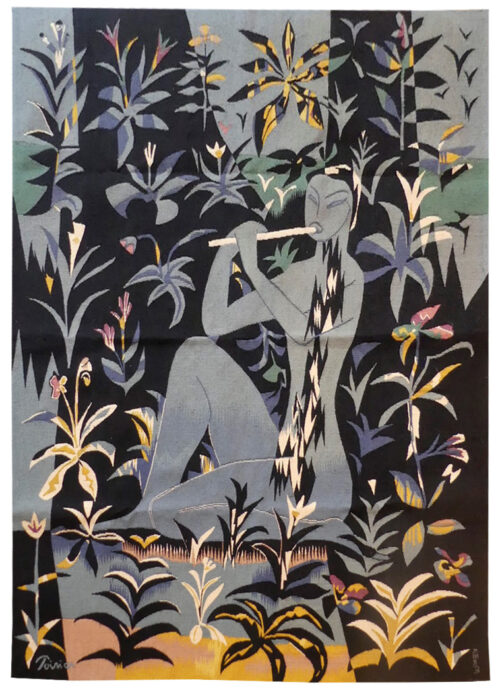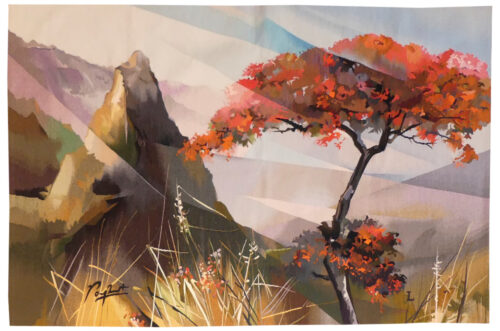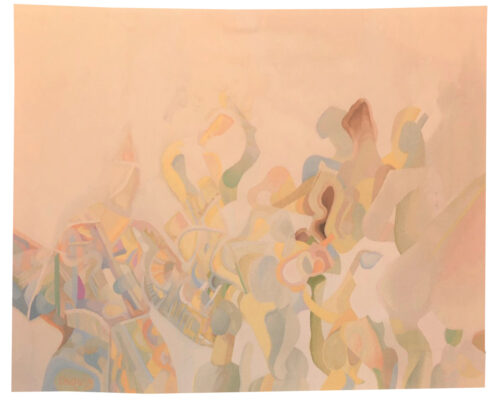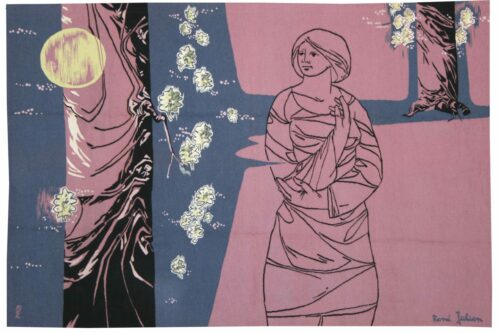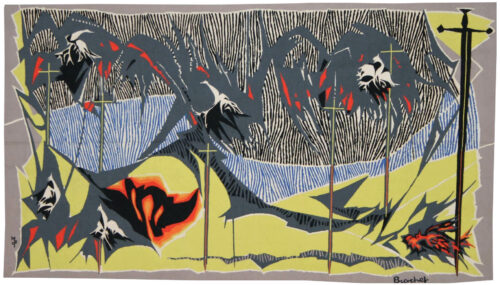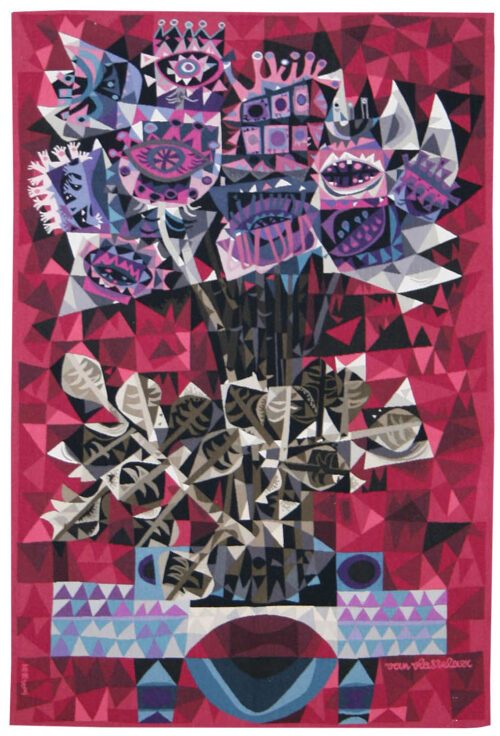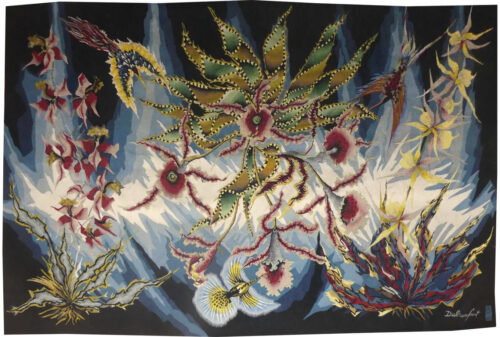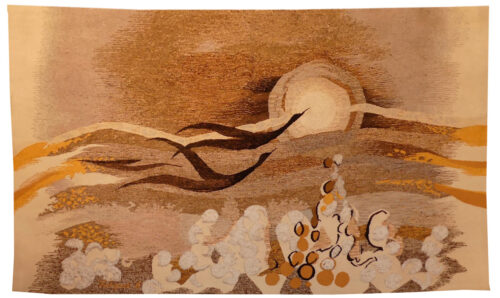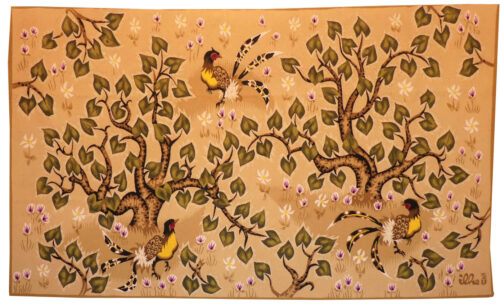-
Concerto
Aubusson tapestry woven by the Berthaut workshop. With signed label. 1957. -
Le feuillage bleu (the blue foliage)
Tapestry woven by the Baudonnet workshop. With signed label. 1965. Jean Picart le Doux is one of the foremost figures in the renaissance of the art of tapestry. His earliest contributions to the field date back to 1943 when he designed cartoons for the passenger ship “la Marseillaise”. A close associate of Lurçat, whose theories he would adopt (limited palette, numbered cartoons…), he was a founding member of the A.P.C.T. (Association des Peintres-cartonniers de Tapisserie), and soon after, a teacher at the Ecole Nationale Supérieure des Arts Décoratifs. The state gave him several commissions most of them at the Aubusson workshop, and some at the Gobelins : the most spectacular of these being for the University of Caen, the Theatre in Le Mans, the passenger ship France or the Prefecture of the Creuse département … In as much as Picart le Doux’s aesthetic is close to that of Lurçat, so also is his inspiration and his subject matter, although in a register which is more decorative than symbolic, where he brings together heavenly bodies (the sun, the moon, the stars…), the elements, nature (wheat, vines, fish, birds…), man, literary quotation … “Rideau de feuilles” [leaf veil], a larger work from 1962 inspired our cartoon. Bruzeau describes it as having a ‘rigid, austere, symmetrical style’ with a ‘Cistercian accent’. Bibliography : Marthe Belle-Joufray, Jean Picart le Doux, Publications filmées d’art et d’histoire, 1966 Maurice Bruzeau, Jean Picart le Doux, Murs de soleil, Editions Cercle d’art, 1972, n°148 Exhibition Catalogue, Jean Picart le Doux, tapisseries, Musée de Saint-Denis, 1976 Exhibition Catalogue Jean Picart le Doux, Boulogne sur Mer, Bibliothèque municipale, 1978 Exhibition Catalogue Jean Picart le Doux, Paris,Musée de la Poste, 1980 Exhibition Catalogue Jean Picart le Doux, Abbaye Saint Jean d’Orbestier, 1992 -
Originally a sculptor exploiting very diverse materials (steel, concrete, clay…), Borderie came to tapestry with immense enthusiasm in the 1950’s with the weaving of his first cartoon in 1957. Receiving encouragement from Denise Majorel, he was awarded the Grand Prix National de la Tapisserie in 1962. In 1974 he was appointed as director at the Ecole Nationale des Arts Décoratifs at Aubusson but he resigned from this post shortly thereafter. He designed over 500 painted cartoons, abstracts using simple shapes, shading in a limited palette of colours and weaving with gros points. A dynamic abstraction with a limited colour scheme running from orange to brown, same preoccupations with light (and shadow) as in ‘les armes de la lumière’ (and as in Matégot's work).: a classic cartoon from André Borderie. Here we find the Bibliography : Exhibition catalogue André Borderie « pour l’homme simplement », Angers, Musée Jean Lurçat et de la Tapisserie Contemporaine, 1998 Exhibition Catalogue André Borderie et la tapisserie d’Aubusson, Aubusson, Manufacture Saint-Jean, 2018Aubusson tapestry woven in the Legoueix workshop. With signed label, n°5/6. Circa 1970.
-
Ciel de Sienne (Sky in Sienna)
Fumeron designed his first cartoons (he would ultimately make over 500) in the 1940’s, in collaboration with the Pinton workshop, he was then commissioned on numerous occasions by the state before participating in the decoration of the ocean liner “France”. His work was figurative to begin with and influenced by Lurçat, then turned towards abstraction, before coming back to a style characterised by colourful figurative and realistic depictions from the 1980’s onwards. The title and the subject of this cartoon combine in a subtle play on words : the opposition of « terre » the earth (the colour sienna in French is “terre de Sienne” ) and “ciel” the sky allows the artist to depict, on a shaded ocre (sienna) background his birds and sun-circle, in the deorative vein so redolent of this particular artist.Aubusson tapestry woven by the Pinton workshop. N°4/6. Circa 1960. -
La lyre aux papillons (Lyre with butterflies)
Aubusson tapestry woven by the Berthaut workshop. With signed label. Circa 1963. Jean Picart le Doux is one of the foremost figures in the renaissance of the art of tapestry. His earliest contributions to the field date back to 1943 when he designed cartoons for the passenger ship “la Marseillaise”. A close associate of Lurçat, whose theories he would adopt (limited palette, numbered cartoons…), he was a founding member of the A.P.C.T. (Association des Peintres-cartonniers de Tapisserie), and soon after, a teacher at the Ecole Nationale Supérieure des Arts Décoratifs. The state gave him several commissions most of them at the Aubusson workshop, and some at the Gobelins : the most spectacular of these being for the University of Caen, the Theatre in Le Mans, the passenger ship France or the Prefecture of the Creuse département … In as much as Picart le Doux’s aesthetic is close to that of Lurçat, so also is his inspiration and his subject matter, although in a register which is more decorative than symbolic, where he brings together heavenly bodies (the sun, the moon, the stars…), the elements, nature (wheat, vines, fish, birds…), man, literary quotation … ‘Natural’ musical instruments (made from blossoming tree branches) are a recurring theme in Picart le Doux's work from 1953 onwards (see ‘La harpe des forêts’ [The Forest Harp]); ‘La harpe aux papillons’ [The Butterfly Harp], vertical with a red background, revisits this theme in 1963. Bibliography : Marthe Belle-Joufray, Jean Picart le Doux, Publications filmées d’art et d’histoire, 1966 Maurice Bruzeau, Jean Picart le Doux, Murs de soleil, Editions Cercle d’art, 1972 Exhibition Catalogue, Jean Picart le Doux, tapisseries, Musée de Saint-Denis, 1976 Exhibition Catalogue Jean Picart le Doux, Musée de la Poste, 1980 -
Les enfants du soleil (Children of the sun)
Toffoli produced a large number of tapestries in collaboration with the Robert Four workshop from 1976 onwards, designing several hundred cartoons. In them we find post-cubist transparent effects which are characteristic of the artist, as indeed are the subjects treated. Thus Toffoli’s tapestries do not differ from his painting : travelling for inspiration, here he illustrates scenes observed during his travels in South America.Aubusson tapestry woven by the Four workshop. With label, n°EA2. Circa 1980. -
Clos d'octobre (october enclosure)
Aubusson tapestry woven in the Andraud workshop. With label, n°EA2. 1978.A student of Léon Detroy, Gaston Thiéry is one of the last representatives of the Crozant school of painting. Estalished in the Creuse region of France, he started working on tapestries in 1965 with the Andraud workshop for whom he designed cartoons inspired by the local flora, in a decorative style which can be situated somewhere between that of Dom Robert and Maingonnat, a world away from his landscape paintings which were strongly influenced by the impressionists. -
Marchands (Traders)
Toffoli produced a large number of tapestries in collaboration with the Robert Four workshop from 1976 onwards, designing several hundred cartoons. In them we find post-cubist transparent effects which are characteristic of the artist, as indeed are the subjects treated. Thus Toffoli’s tapestries do not differ from his painting : travelling for inspiration, here he illustrates scenes observed during his travels in South America.Aubusson tapestry woven by the Four workshop. With signed label, n°EA2/2. Circa 1980. -
Bouquet papillon (bunch butterfly)
Aubusson tapestry woven in the Legoueix workshop. With signed label, n°4/6. Circa 1980.From illustration to tapestry, there's only one (big) step to take - remember that Dom Robert was an illuminator! It was he, and Madeleine David, one of the co-directors of the La Demeure gallery, with whom she was close, that encouraged Jacqueline Duhême to take up the medium: preceded by her reputation as an “imagière” (cf. bibliography), illustrating Prévert, Eluard and Druon, she devoted herself to tapestry from 1967 (when she took classes with Tourlière at the ENAD in Aubusson, and became an enthusiast of numbered cartoons) to 1981, with La Demeure even devoting a solo exhibition to her in 1976. Her world, inspired by medieval mille-fleurs tapestries, is also reminiscent of dom Robert, but a dom Robert on amphetamines, where Nature is abundant, exotic and exuberant (cf. ‘Safari’, ‘l'oiseau de Paradis’). On a smaller, more polished scale, our cartoon bears witness to the colourful vitality of Duhême's inspiration. Bibliography : Cat. Expo. Jacqueline Duhême l’imagière, bibliothèque Forney, 2019 -
Aube quarte (fourth dawn)
Marc Petit met Jean Lurçat in 1954, went to Aubusson in 1955, exhibited his work for the first time at La Demeure in 1956, became a member of the A.P.C.T. (Association des Peintres-Cartonniers de Tapisserie) in 1958. After this lightning start to his career, he produced hundreds of cartoons, in a style all his own, where long-legged waders and acrobats wend in and out of dreamscapes. Again, economy of means, with broad flat tints and a narrow chromatic range, for a singular dawn. a theme that the artist is fond of (cf. ‘le pas de l'aube’, but also “Aurore”, ‘la nuit s'éteint’ ....). As for the flock of passing birds, this is another leitmotif, seen in ‘aube courte’ for example.Aubusson tapestry woven in the Picaud workshop. With signed label, n°2/4. Circa 1970. -
Laissez les vivre (let them live)
Aubusson tapestry woven in the Tabard workshop. With signed label, n°6/8. Circa 1970.Henri Ilhe, who came to the design of tapestry cartoons late on in his career, still managed to produce from 1964 onwards a considerable number (more than 120, all woven by the Tabard workshop) in an urbane style, incorporating birds and butterflies sporting in and around the gnarled branches of trees and bushes. “Laissez les livre” is thus, characteristic of Ilhe’s bucolic inspiration. -
Le coquillage étoilé (the starry seashell)
Aubusson tapestry woven by the Berthaut workshop. With label signed by the artist. 1959. Jean Picart le Doux is one of the foremost figures in the renaissance of the art of tapestry. His earliest contributions to the field date back to 1943 when he designed cartoons for the passenger ship “la Marseillaise”. A close associate of Lurçat, whose theories he would adopt (limited palette, numbered cartoons…), he was a founding member of the A.P.C.T. (Association des Peintres-cartonniers de Tapisserie), and soon after, a teacher at the Ecole Nationale Supérieure des Arts Décoratifs. The state gave him several commissions most of them at the Aubusson workshop, and some at the Gobelins : the most spectacular of these being for the University of Caen, the Theatre in Le Mans, the passenger ship France or the Prefecture of the Creuse département … In as much as Picart le Doux’s aesthetic is close to that of Lurçat, so also is his inspiration and his subject matter, although in a register which is more decorative than symbolic, where he brings together heavenly bodies (the sun, the moon, the stars…), the elements, nature (wheat, vines, fish, birds…), man, literary quotation … Our tapestry reproduces the left-hand side of a cartoon of the same title dating from 1959. Although Picart le Doux's early tapestries feature marine motifs, he soon moved towards less allegorical, more realistic representations. Bibliography : Marthe Belle-Joufray, Jean Picart le Doux, Publications filmées d’art et d’histoire, 1966 Maurice Bruzeau, Jean Picart le Doux, Murs de soleil, Editions Cercle d’art, 1972, n°91 Exhibition Catalogue, Jean Picart le Doux, tapisseries, Musée de Saint-Denis, 1976 Exhibition Catalogue Jean Picart le Doux, Boulogne sur Mer, Bibliothèque municipale, 1978, n°17 Exhibition Catalogue Jean Picart le Doux, Paris,Musée de la Poste, 1980 Exhibition Catalogue Jean Picart le Doux, Abbaye Saint Jean d’Orbestier, 1992, ill. -
Survol (flying over)
Aubusson tapestry woven by the Legoueix workshop. With signed label, n°5/6. 1974. It was in 1953 that Jean Picart le Doux proposed to Chaye to become his assistant and encouraged him to design tapestry cartoons : he would produce numerous bucolic cartoons, but also views of Normandy (Mont Saint Michel, Honfleur, regattas,...) whence he came. These compositions “as the bird flies” are typical of the artist. Bibliography : Simon Chaye tapisseries contemporaines, Editions Librairie des musées, 2014, ill. p.83 -
Mond und Wasser (Moon and Water)
Tapestry woven by the Münchener Gobelin Manufaktur. Circa 1970.Holger was a student at the Ecole Nationale d’Art Décoratif d’Aubusson and worked with Lurçat before the latter’s death in 1966. He designed numerous dream-like cartoons woven by the Aubusson workshop. Now settled in the United States, he remains a tireless advocate for, and witness to, modern tapestry design, organising exhibitions and lectures on the subject. Some of his cartoons have been woven in the two workshops active in Germany, in Nuremberg and Munich, using Aubusson techniques. -
Feuer und Wasser (Fire and Water)
Tapestry woven by the Münchener Gobelin Manufaktur. With signed label. Circa 1970. Holger was a student at the Ecole Nationale d’Art Décoratif d’Aubusson and worked with Lurçat before the latter’s death in 1966. He designed numerous dream-like cartoons woven by the Aubusson workshop. Now settled in the United States, he remains a tireless advocate for, and witness to, modern tapestry design, organising exhibitions and lectures on the subject. Some of his cartoons have been woven in the two workshops active in Germany, in Nuremberg and Munich, using Aubusson techniques. -
Opaline
Aubusson tapestry woven by the Pinton workshop. With label, n°1/6. Circa 1980.Best known as an engraver, Davo reproduces in tapestry the result of his research in that medium, based on the oxydation of different metals placed on the copper plate, hence its iridescent-solarizing effects. -
Moulin (mill)
Aubusson tapestry woven by the Glaudin-Brivet workshop. With label, n°3/6. 1974. Bibliography : Simon Chaye tapisseries contemporaines, Editions Librairie des musées, 2014, ill. p.40 -
Kenya
On returning to France in the 1950’s after a lengthy period spent in Argentina, Berroeta produced quite a number of cartoons in a style which was first figurative (animals, human figures,...) then turned to abstraction, as in his paintings. Exotic inspiration is a recurrent theme in Berroeta's work, often in an allusive way: neither the animals nor the plants are definitively identifiable, together, they have an allegorical purpose.Aubusson tapestry woven by the Pinton workshop. With signed label. Circa 1960. -
Composition orange
Aubusson tapestry woven by le mur du nomade workshop. N°1/6. Circa 1970.Fumeron designed his first cartoons (he would ultimately make over 500) in the 1940’s, in collaboration with the Pinton workshop, he was then commissioned on numerous occasions by the state before participating in the decoration of the ocean liner “France”. His work was figurative to begin with and influenced by Lurçat, then turned towards abstraction, before coming back to a style characterised by colourful figurative and realistic depictions from the 1980’s onwards. The setting sun, the orange chromatic range and the composition on the edge between figuration and abstraction are characteristic of the artist's cartoons from this period. -
Le grand large (the wide, open sea)
Toffoli produced a large number of tapestries in collaboration with the Robert Four workshop from 1976 onwards, designing several hundred cartoons. In them we find post-cubist transparent effects which are characteristic of the artist, as indeed are the subjects treated. Thus Toffoli’s tapestries do not differ from his painting : travelling for inspiration, here he illustrates a junk observed during trips to the far East.Aubusson tapestry woven by the Four workshop. N°1/6. Circa 1980. -
Le pêcheur (the fisherman)
Lurçat’s artistic production was immense : it is however his role as the renovator of the art of tapestry design which ensures his lasting renown. As early as 1917, he started producing works on canvas, then in the 20’s and 30’s, he worked with Marie Cuttoli. His first collaboration with the Gobelins workshop dates back to 1937, at the same time he discovered the tapestry of the Apocalypse which was essential in his decision to devote himself to tapestry design. He first tackled the technical aspects with François Tabard, then on his installation at Aubusson during the war, he established his technique : broad point, a simplified palette, outlined cartoons with colours indicated by pre-ordained numbers. A huge production then follows (over 1000 cartoons) amplified by his desire to include his painter friends, the creation of the A.P.C.T. (Association des Peintres-Cartonniers de Tapisserie) and the collaboration with the art gallery La Demeure and Denise Majorel, and then by his role as a tireless advocate for the medium around the world. His tapestries reveal a pictorial world which is specifically decorative, with a very personal symbolic iconography : cosmogony (the sun, the planets, the zodiac, the four elements…) stylised vegetation, fauna (rams, cocks, butterflies, chimera …) standing out against a background without perspective (voluntarily different from painting) and, in his more ambitious work, designed as an invitation to share in a poetic (he sometimes weaves quotations into his tapestries) and philosophical (the grand themes are broached from the wartime period onwards) vision whose climax is the “Chant du Monde” (Song of the World) (Jean Lurçat Museum , ancien hôpital Saint Jean, Angers) which remained unfinished at his death. This is an inverted fragment of a larger cartoon (250 x 180 cm). The themes of fishing and hunting, often echoing each other (the net itself is sometimes used to catch birds), are recurrent (see the ‘Hunting and fishing’ cartoon, Fraysse auction 19.10.2011 n°10 for example), illustrating a confrontation between Man and Nature. Bibliography : Tapisseries de Jean Lurçat 1939-1957, Pierre Vorms Editeur, 1957, ill. n°17 Exhibition Catalogue Lurçat, 10 ans après, Musée d'Art moderne de la ville de Paris, 1976 Exhibition catalogue Les domaines de Jean Lurçat, Angers, Musée Jean Lurçat et de la tapisserie contemporaine, 1986 Symposium Jean Lurçat et la renaissance de la tapisserie in Aubusson, Aubusson, Musée départemental de la tapisserie 1992 Exhibition Catalogue Dialogues avec Lurçat, Musées de Basse-Normandie, 1992 Exhibition catalogue Jean Lurçat, Donation Simone Lurçat, Académie des Beaux-Arts, 2004 Jean Lurçat, le chant du monde Angers 2007 Gérard Denizeau, Jean Lurçat, Liénart, 2013 Exhibition Catalogue Jean Lurçat au seul bruit du soleil, Paris, galerie des Gobelins, 2016Aubusson tapestry woven in the Braquenié workshop. With a certificate from the artist's widow. Circa 1955. -
Procyon
Aubusson tapestry woven by the Legoueix workshop. With signed label, n°3/4. 1968.A member of the A.P.C.T. (Association des Peintres-Cartonniers de Tapisserie), Wogensky is one of the many artists who would follow in Lurçat’s footsteps immediately after the war. At first influenced by his predecessor, Wogensky’s subsequent work (159 cartoons according to the 1989 exhibition catalogue) would evolve during the 1960’s towards a, not completely self-avowed, lyrical abstraction, from cosmic-astronomical themes expressed in decomposed, moving, birdlike shapes to cartoons both more refined and less dense. Although always claiming to be a painter, the artist’s conception of tapestry is extremely well thought out : “the realisation of a mural cartoon.... requires the consideration of a space which is no longer ours alone, by the nature of its dimensions, its scale, it also imposes a grand gesture which transforms and accentuates our presence.” « Procyon » is a work inspired by Wogensky’s « cosmic » vein (it’s title alone bears witness to the fact) which lasted through the 1960’s and of which “Cosmos” (1968 Strasbourg University) and “Galaxy” (1970, Sénat Palais du Luxembourg) would be the high points. Shading (omnipresent) and blocks of colour co-exist in a subtle harmony, evoking a curious, unknown world with elements of the infinitely small as seen through a microscope and the infinitely large. A similar tapestry is kept at the Musée Jean Lurçat et de la Tapisserie Contemporaine in Angers. Bibliography : Exhibition catalogue Robert Wogensky, Aubusson, Musée départemental de la tapisserie, 1989 Exhibition catalogue Robert Wogensky, Angers, Musée Jean Lurçat et de la Tapisserie Contemporaine, 1989 Exhibition catalogue Tissages d’ateliers, tissages d’artistes, 10 ans d’enrichissement des Collections, Angers, Musée Jean Lurçat et de la Tapisserie Contemporaine, 2004, ill. p.101 Exhibition catalogue Collections ! Collections !, Angers, Musée Jean Lurçat et de la Tapisserie Contemporaine, 2019-2020, ill. p.11 -
Papillon (butterfly)
Edmond Dubrunfaut can be considered as the great 20th century renovator of the Belgian tapestry tradition. He founded a weavers’ workshop in Tournai as early as 1942, then, in 1947, created the Centre de Rénovation de la Tapisserie de Tournai. He produced for various Belgian workshops (Chaudoir, de Wit,...) numerous cartoons destined notably to adorn Belgian embassies throughout the world. Moreover, Dubrunfaut was a teacher of monumental art forms at the Academie des Beaux-Arts de Mons from 1947 to 1978 and then, in 1979, contributed to the creation of the Fondation de la tapisserie, des arts du tissu et des arts muraux de Tournai, a veritable heritage centre for the art of the tapestry in Wallonie. His style, characterised by figuration, strong colour contrasts, draws direct inspiration from nature and animal life (as with Perrot, for example, this artist has a net predilection for birdlife). Dubrunfaut, as well as having his works woven in Belgium, gave numerous cartoons to the Four manufacture in Aubusson : birds and butterflies combine with exotic flowers in sharp, bright colours on a midnight blue background. Bibliography : Exhibition catalogue Dubrunfaut et la renaissance de la tapisserie, tableaux, dessins, peintures, Musée des Beaux-Arts de Mons, 1982-1983Aubusson tapestry woven by the Four workshop. N°3/6. Circa 1970. -
Rives (shores)
Lurçat’s artistic production was immense : it is however his role as the renovator of the art of tapestry design which ensures his lasting renown. As early as 1917, he started producing works on canvas, then in the 20’s and 30’s, he worked with Marie Cuttoli. His first collaboration with the Gobelins workshop dates back to 1937, at the same time he discovered the tapestry of the Apocalypse which was essential in his decision to devote himself to tapestry design. He first tackled the technical aspects with François Tabard, then on his installation at Aubusson during the war, he established his technique : broad point, a simplified palette, outlined cartoons with colours indicated by pre-ordained numbers. A huge production then follows (over 1000 cartoons) amplified by his desire to include his painter friends, the creation of the A.P.C.T. (Association des Peintres-Cartonniers de Tapisserie) and the collaboration with the art gallery La Demeure and Denise Majorel, and then by his role as a tireless advocate for the medium around the world. His tapestries reveal a pictorial world which is specifically decorative, with a very personal symbolic iconography : cosmogony (the sun, the planets, the zodiac, the four elements…) stylised vegetation, fauna (rams, cocks, butterflies, chimera …) standing out against a background without perspective (voluntarily different from painting) and, in his more ambitious work, designed as an invitation to share in a poetic (he sometimes weaves quotations into his tapestries) and philosophical (the grand themes are broached from the wartime period onwards) vision whose climax is the “Chant du Monde” (Song of the World) (Jean Lurçat Museum , ancien hôpital Saint Jean, Angers) which remained unfinished at his death. The abundant plant and fish motifs respond to each other, but in a typical Lurçat inversion, with the aquatic element above the banks. Bibliography : Tapisseries de Jean Lurçat 1939-1957, Pierre Vorms Editeur, 1957 Exhibition Catalogue Lurçat, 10 ans après, Musée d'Art moderne de la ville de Paris, 1976 Exhibition catalogue Les domaines de Jean Lurçat, Angers, Musée Jean Lurçat et de la tapisserie contemporaine, 1986 Symposium Jean Lurçat et la renaissance de la tapisserie in Aubusson, Aubusson, Musée départemental de la tapisserie 1992 Exhibition Catalogue Dialogues avec Lurçat, Musées de Basse-Normandie, 1992 Exhibition catalogue Jean Lurçat, Donation Simone Lurçat, Académie des Beaux-Arts, 2004 Jean Lurçat, le chant du monde Angers 2007 Gérard Denizeau, Jean Lurçat, Liénart, 2013 Exhibition Catalogue Jean Lurçat au seul bruit du soleil, Paris, galerie des Gobelins, 2016Aubusson tapestry woven in the Goubely workshop. With label. Circa 1955. -
Vendémiaire
The story is well known: following the commission for the ‘4 Parts of the World’ to be woven at the Gobelins, Dubreuil was one of the 3 artists, along with Gromaire and Lurçat, sent by Guiillaume Janneau, administrator of the Manufactures Nationales, to Aubusson at the end of 1939, to renovate local tapestry production (with the commission for a set of tapestries on the theme of Gardens). Although he shared Lurçat's ideas on the influence that medieval tapestry should have in revitalising the medium, his abundant and resolutely naturalistic cartoons (lacking the dreamlike quality of Coutaud, for example) distanced him from his colleague, in favour of a closer relationship with the work of Maingonnat. Our tapestry bears witness to Dubreuil's collaboration with Antoine Behna's A.R.T. (Atelier de Rénovation de la Tapisserie), of which Janneau, discredited for his role during the War, was the artistic and technical adviser. The allegorical register bears witness to Dubreuil's classicism, between academic nudes and still lifes reflecting the History of Painting. This workshop wove in both high and low heddle : the 1990 sale catalogue included one example woven in each technique. Bibliography : G. Janneau, A. Behna, Tapisseries de notre temps, 1950, ill. n°64 Millon-Robert sale catalogue 3.10.1990 n°28-29, 64Tapestry woven by Coffinet for Ami de la Paix. Circa 1945. -
Les chouettes (the owls)
Edmond Dubrunfaut can be considered as the great 20th century renovator of the Belgian tapestry tradition. He founded a weavers’ workshop in Tournai as early as 1942, then, in 1947, created the Centre de Rénovation de la Tapisserie de Tournai. He produced for various Belgian workshops (Chaudoir, de Wit,...) numerous cartoons destined notably to adorn Belgian embassies throughout the world. Moreover, Dubrunfaut was a teacher of monumental art forms at the Academie des Beaux-Arts de Mons from 1947 to 1978 and then, in 1979, contributed to the creation of the Fondation de la tapisserie, des arts du tissu et des arts muraux de Tournai, a veritable heritage centre for the art of the tapestry in Wallonie. His style, characterised by figuration, strong colour contrasts, draws direct inspiration from nature and animal life (as with Perrot, for example, this artist has a net predilection for birdlife). From 1955 and throughout the 1960s, the Wit manufactory wove a considerable number of tapestries after Dubrunfaut, the human figure soon giving way to floral subjects and, above all, of birds. Bibliography : Exhibition catalogue Dubrunfaut et la renaissance de la tapisserie, tableaux, dessins, peintures, Musée des Beaux-Arts de Mons, 1982-1983.Tapestry woven by the de Wit workshop. Circa 1960. -
Les enfants (children)
Toffoli produced a large number of tapestries in collaboration with the Robert Four workshop from 1976 onwards, designing several hundred cartoons. In them we find post-cubist transparent effects which are characteristic of the artist, as indeed are the subjects treated. Thus Toffoli’s tapestries do not differ from his painting : travelling for inspiration, here he illustrates children playing in a street on the other side of the planet.Aubusson tapestry woven by the Four workshop. With illegible label, n°EA. Circa 1980. -
Le luth et le chandelier (the lute and the candelabra)
Aubusson tapestry woven by the Hamot workshop. With signed label, n°2/8. Circa 1955. Jean Picart le Doux is one of the foremost figures in the renaissance of the art of tapestry. His earliest contributions to the field date back to 1943 when he designed cartoons for the passenger ship “la Marseillaise”. A close associate of Lurçat, whose theories he would adopt (limited palette, numbered cartoons...), he was a founding member of the A.P.C.T. (Association des Peintres-cartonniers de Tapisserie), and soon after, a teacher at the Ecole Nationale Supérieure des Arts Décoratifs. The state gave him several commissions most of them at the Aubusson workshop, and some at the Gobelins : the most spectacular of these being for the University of Caen, the Theatre in Le Mans, the passenger ship France or the Prefecture of the Creuse département ... In as much as Picart le Doux’s aesthetic is close to that of Lurçat, so also is his inspiration and his subject matter, although in a register which is more decorative than symbolic, where he brings together heavenly bodies (the sun, the moon, the stars...), the elements, nature (wheat, vines, fish, birds...), man, literary quotation ... In this cartoon (strangely absent from Bruzeau’s book), the accent is squarely placed by the title on the chandelier itself, but there are familiar aspects of the artist’s habitual repertoire, reflecting a past, ideal golden age, with the viola da gamba and the butterflies. The inclusion of these motifs and the red background are both reminiscent of the 1955 tapestry Damier (checkerboard) (Bruzeau n° 68) Bibliography : Marthe Belle-Joufray, Jean Picart le Doux, Publications filmées d’art et d’histoire, 1966 Maurice Bruzeau, Jean Picart le Doux, Murs de soleil, Editions Cercle d’art, 1972 Exhibition Catalogue, Jean Picart le Doux, tapisseries, Musée de Saint-Denis, 1976 Exhibition Catalogue Jean Picart le Doux, Musée de la Poste, 1980 -
Le jardin d'amour (the garden of love)
Tapestry, probably woven in Aubusson. 1947. Lurçat approached Saint-Saëns, originally a painter of murals, in 1940. And during the war the latter produced the first of his allegorical masterpieces, tapestries reflecting indignation, combat, resistance : “les Vierges folles (the foolish virgins), “Thésée et le Minotaure” (Theseus and the Minotaur). At the end of the war, as a natural development he joined up with Lurçat, whose convictions he shared (concerning a simplified palette, outlined cartoons with colours indicated by pre-ordained numbers, and the specific nature of tapestry design…) at the A.P.C.T. (Association des Peintres-cartonniers de Tapisserie). His universe, where the human figure, stretched, elongated, ooccupies an important place (particularly when compared to his companions Lurçat or Picart le Doux), pivots around traditional themes : woman, the Commedia dell’arte, Greek mythology… refined by the brilliance of the colours and the simplification of the layout. His work would evolve later, in the 1960’s, towards cartoons of a more lyrical design, almost abstract where elemental and cosmic forces would dominate. ‘Le jardin d'amour’, an evocative allegory of the terrestrial paradise sometimes illustrated in the Middle Ages and the Renaissance, bears witness to the classical references of Saint-Saëns who, in the same year, conceived "Orphée" and "La Comédie italienne" : theatre, ancient myths and biblical references (the “Vierges folles” cartoon also comes to mind) were omnipresent sources of inspiration. Bibliography : Exhibition catalogue Saint-Saëns, the tapestries, Aubusson, Musée départemental de la Tapisserie, 1987 Exhibition catalogue Marc Saint-Saëns, tapestries, 1935-1979, Angers, Musée Jean Lurçat et de la Tapisserie Contemporaine 1997-1998 -
Les grands pins (the tall pines)
Aubusson tapestry woven in the Pinton workshop for the Verrière gallery. With label, n°1/1. Circa 1965. With a taste for the large-scale, influenced by Untersteller at the Ecole des Beaux Arts, Hilaire undertook numerous mural paintings. In the same vein, beginning in 1949, along with a number of other artists stimulated by Lurçat, (he would join the latter at the A.P.C.T. Association des Peintres-Cartonniers de Tapisserie) he designed a number of cartoons ( over a score) some of which were woven at Beauvais or at Les Gobelins. In this piece we come upon one of the artist’s leitmotivs in his tapestry cartoons : tracing light rays as they fall through foliage in a forest, found for example in “Soleil dans les arbres” (Sun in the trees), (but it was already the subject of “Forêt de france” for the “France” ocean liner). Here the concentrated colour scheme gives an effect of stained glass which is particularly striking, and which is redolent of the artist’s many realisations in this medium, notably in the churches of Moselle. Bibliography : Exhibition catalogue, Hilaire œuvre tissé, galerie Verrière 1970 Exhibition catalogue, Hilaire, du trait à la lumière, Musée Départemental Georges de la Tour à Vic-sur-Seille, 2010. -
Pampa
Aubusson tapestry woven by the Four workshop. With label, n°2/6. Circa 1990.Despite considering herself first and foremost a sculptor, Hedva Ser also produced some cartoons, woven at the Four workshop in Aubusson, which evoke atmospheric scenes (there are also “Esterel”, “Sinaï”, “Océan”...), where clouds, reflections, waves and dunes... are represented by the effective use of different threads and stitches. -
Le hibou (the owl)
Elie Maingonnat governed the Ecole Nationale des Arts Décoratifs d’Aubusson from 1930 until 1958 where he took over from Marium Martin (who already recommended the use of a limited number of colours and the use of hachures, a similar technique to hatching) of whom he was a pupil. As well as assuming the responsibilities of his position, Maingonnat devoted himself to designing cartoons : motifs of dense vegetation animated by the presence of a few animals, both of which were inspired by the flora and fauna of the Limousin area of France revitalising the traditional theme of the Aubusson "verdures" used in the XVIIth and XVIIIth centuries. Our carton is typical of Maingonnat's work: the local flora and fauna, as if in symbiosis, are illustrated in a reduced range of autumnal colours. Bibliography : Exhibition catalogue Elie Maingonnat, Aubusson, Musée départemental de la Tapisserie, 1986-1987Aubusson tapestry woven by the Avignon workshop. With label signed by the artist's beneficiary. 1959. -
Gerbe (Sheaf)
Aubusson tapestry woven by the Legoueix workshop. N°4/6. 1985. It was in 1953 that Jean Picart le Doux proposed to Chaye to become his assistant and encouraged him to design tapestry cartoons : he would produce numerous bucolic cartoons, but also views of Normandy (Mont Saint Michel, Honfleur, regattas,…) whence he came. These compositions “as the bird flies” are typical of the artist. Here, the fields beneath their wings, in a geometrical evocation of the countryside in summer, are associated with a magnified (or metaphorical) representation of the crops planted therein (wheat, corn,…). Bibliography : Simon Chaye tapisseries contemporaines, Editions Librairie des musées, 2014, ill. p.80 -
Faisan (phaesant)
Perrot began his career as a cartoon designer at the end of the war, making almost 500 cartoons including numerous commissions from the state, most of which were woven at Aubusson. His style which is particularly rich and decorative is eminently recognisable : a crowd of butterflies or birds, most often, stands out against a background of vegetation, reminiscent of the millefleurs tapestries (which would also inspire Dom Robert). The ornithological subject, the abundance of motifs inspired by medieval « mille-fleurs » tapestries and the plain background (in this case, using the famous ‘Perrot blue’ as it was known in the Pinton workshops, repeatedly used in numerous cartoons) make our tapestry an exemplary model of Perrot's art from the 1960s onwards. Bibliography : Tapisseries, dessins, peintures, gravures de René Perrot, Dessein et Tolra, 1982 Cat. Expo. René Perrot, mon pauvre cœur est un hibou, Aubusson, Cité de la Tapisserie, 2023Aubusson tapestry woven by the Pinton workshop. With signed label. Circa 1960. -
Fleurs (flowers)
Edmond Dubrunfaut can be considered as the great 20th century renovator of the Belgian tapestry tradition. He founded a weavers’ workshop in Tournai as early as 1942, then, in 1947, created the Centre de Rénovation de la Tapisserie de Tournai. He produced for various Belgian workshops (Chaudoir, de Wit,...) numerous cartoons destined notably to adorn Belgian embassies throughout the world. Moreover, Dubrunfaut was a teacher of monumental art forms at the Academie des Beaux-Arts de Mons from 1947 to 1978 and then, in 1979, contributed to the creation of the Fondation de la tapisserie, des arts du tissu et des arts muraux de Tournai, a veritable heritage centre for the art of the tapestry in Wallonie. His style, characterised by figuration, strong colour contrasts, draws direct inspiration from nature and animal life (as with Perrot, for example, this artist has a net predilection for birdlife). A late tapestry by Dubrunfaut, in an ever-renewed decorative vein, woven at the CRECIT in Tournai, where the artist gave many cartoons . Bibliography : Exhibition catalogue Dubrunfaut et la renaissance de la tapisserie, tableaux, dessins, peintures, Musée des Beaux-Arts de Mons, 1982-1983.Tapestry woven by the CRECIT. With label. 1999. -
Les fruits d'or (the golden fruits)
Aubusson tapestry woven in the Tabard workshop. With signed label. Circa 1965.Henri Ilhe, who came to the design of tapestry cartoons late on in his career, still managed to produce from 1964 onwards a considerable number (more than 120, all woven by the Tabard workshop) in an urbane style, incorporating birds and butterflies sporting in and around the gnarled branches of trees and bushes. “Les fruits d'or” is thus, characteristic of Ilhe’s bucolic inspiration. -
Composition
Little is known about the artist, but she created a number of cartoons, which would be woven in the 60’s by Tabard and Pinton.Aubusson tapestry woven by the Pinton workshop. With label. Circa 1965. -
Chardons aux papillons blancs (Thistles with white butterflies)
Elie Grekoff, whose aesthetic is similar to that of Lurçat, designed over 300 cartons until the early 1980s. Here we find the sharp shapes typical of tapestry in the immediate post-war period. Note the motif which, amusingly enough, goes beyond the border-frame.Aubusson tapestry woven by the Caron workshop. With signed label, n°EA. Circa 1970. -
Sumatra
Aubusson tapestry woven by the Four workshop. With signed label, n°EA. Circa 1960.Fumeron designed his first cartoons (he would ultimately make over 500) in the 1940’s, in collaboration with the Pinton workshop, he was then commissioned on numerous occasions by the state before participating in the decoration of the ocean liner “France”. His work was figurative to begin with and influenced by Lurçat, then turned towards abstraction, before coming back to a style characterised by colourful figurative and realistic depictions from the 1980’s onwards Fumeron's work in the 60s had a touch of the exotic about it, with his ‘Osaka’, ‘Samurai’ and ‘Monsoon’ cartoons coming to mind. But there's no literal evocation: the partially obstructed circle (Sun?) remains a leitmotif, whatever the title. -
Sérénade à la lune (moon serenade)
Aubusson tapestry woven by the Braquenié workshop. N°IV/VI. 1952.Initiated into the art of tapestry design by Jean Picart le Doux, Poirier produced his first cartoon in 1951 : he was to produce twenty-odd cartoons during the 1950's, which led him to be considered as one of the great hopes for the new Tapestry movement. However from the 60's onwards, he returned to painting. ‘Sérénade à la lune’ was originally a large-scale cartoon (190 x 285 cm) commissioned by Jacques Adnet in 1952. Our tapestry uses the left-hand side of the composition, reduced in height and inverted, without the moon. This fragmentation met the needs of a clientele eager for small formats. Bibliography : J. Cassou, M. Damain, R. Moutard-Uldry, la tapisserie française et les peintres cartonniers, Tel, 1957, ill. p.182 -
Paysage au flamboyant (landscape with flamboyant)
In a similar vein to Toffoli, Raymond Poulet criss-crossed the world and his travels provided the themes that inspired his work.Aubusson tapestry woven by the Jean Laurent workshop. N°6/6. Circa 1990. -
Le clown (the clown)
Aubusson tapestry woven by the Hecquet workshop. With signed label, n°1/1. 1974.Best known for his compositions inspired by the theme of the Circus (his favourite theme, across all techniques: a sculpted acrobat figure adorns the public space in Aubusson), Cinquin, who moved to Aubusson and taught at the Ecole Nationale d’Art Décoratif there until it closed, was (he died in 2019) one of the last artists to have known personally the protagonists of the movement for the renaissance of modern tapestry. -
Composition
Aubusson tapestry woven in the Henry workshop. With signed label, n°1/1. 1984.Like other sculptors (Gilioli, Adam, Ubac...), Hairabédian turned to tapestry (his studio was located in Creuse from 1975 to 1985). In the absence of volume, his spectacular composition plays on the size of weaving stitches, the hollowing out of space with the blank warp... processes typical of the ‘New Tapestry’. -
Lente approche (slow approach)
Aubusson tapestry woven in the Braquenié workshop. With label. Circa 1960.From his long artistic career, which began in the 1950s (and which later focused mainly on sculpture), Julien produced around twenty tapestries from 1959 onwards, mainly woven by the Braquenié factory, including ‘Le commerce extérieur’ (Foreign Trade), a spectacular 12 m² public commission. His style often features female figures drawn in black, with sober colours and patterns, of which our cartoon is a prime example. Bibliography : Léon-Louis Sosset, Tapisserie contemporaine en Belgique, Perron, 1989 -
Les épées d'or (the golden swords)
Aubusson tapestry woven in the Braquenié workshop. With label. 1955.Jacques Brachet was an important protagonist of the « New Tapestry » movement ; woven by Pierre Daquin, exhibited by the « La Demeure » gallery in the 1970’s, his innovative and experimental approach to the medium, from the 1950’s onwards, was recognised by the Centre International d’études pédagogiques in Sèvres, by the scenography of “La Tapisserie en France, 1945 – 1985, la tradition vivante” at the Ecole Nationale Supérieure des Beaux-Arts, and by his inclusion in various promotional events right up to the present day. Before his explorations of the 70s, Brachet produced 6 cartoons in the 50s, which met with modest success (they are all unique pieces). While the martial theme, linked to the practice of fencing, is unprecedented, the aesthetic is close to that of other peintres-cartonniers of the period, such as Jullien. Bibliography : Exhibition catalogue Jacques Brachet, mémoires océanes, Angers, Musée Jean Lurçat et de la tapisserie contemporaine, 1996 -
Bouquet d'anniversaire (Birthday bouquet)
Van Vlasselaer (1907-1982) is known for having created numerous monumental wall paintings as well as stain glass windows. From 1950 onwards he created tapestry cartoons inspired by scenes of everyday life, traditional Flemish folklore and natural subjects in keeping with the aesthetic of the group “Forces Murales”. He evolved from the figurative of his early work towards dense designs incorporating sharp-edged foliage laid out against geometrically inspired backgrounds influenced by Cubism. “From 1969 onwards, his style became ever more flamboyant. One of the most remarkable examples is without doubt “Bouquet d’anniversaire”... on a monumental scale... Each detail is strikingly original. The foliage and the blossoms are rendered in such a way to take them beyond their natural condition in a fantastical style that still retains a certain rigour...” (R. Avermaete, van Vlasselaer Tapisseries, p.97) Bibliography : R. Avermaete, van Vlasselaer Tapisseries, Editions Arcade, 1973, ill. p.88Tapestry woven by the Braquenié workshop. 1969. -
Flore des tropiques (tropical flora)
Aubusson tapestry woven in the Four workshop. With label, n°EA. Circa 1975.Bibliography : Exhibition catalogue Dubrunfaut et la renaissance de la tapisserie, tableaux, dessins, peintures, Musée des Beaux-Arts de Mons, 1982-1983Edmond Dubrunfaut can be considered as the great 20th century renovator of the Belgian tapestry tradition. He founded a weavers’ workshop in Tournai as early as 1942, then, in 1947, created the Centre de Rénovation de la Tapisserie de Tournai. He produced for various Belgian workshops (Chaudoir, de Wit,...) numerous cartoons destined notably to adorn Belgian embassies throughout the world. Moreover, Dubrunfaut was a teacher of monumental art forms at the Academie des Beaux-Arts de Mons from 1947 to 1978 and then, in 1979, contributed to the creation of the Fondation de la tapisserie, des arts du tissu et des arts muraux de Tournai, a veritable heritage centre for the art of the tapestry in Wallonie. His style, characterised by figuration, strong colour contrasts, draws direct inspiration from nature and animal life (as with Perrot, for example, this artist has a net predilection for birdlife). Towards the end of his career, Dubrunfaut tended to a language of fantasy (whose sharpened forms are reminiscent of Marc Petit), and whose use of motif (humming birds and exotic vegetation) looks over its shoulder at Lurçat. -
Composition
Aubusson tapestry woven in the Four workshop. N°6/6. Circa 1980.A former student at the ENAD in Aubusson, Lartigaud created his first tapestry cartoon in 1968. He went on to design hundreds more, most of them woven by the Four Workshop, in a, more often than not, abstract style, with a few exceptions, as shown here by the presence of 2 birds. -
Chantelune
Henri Ilhe, who came to the design of tapestry cartoons late on in his career, still managed to produce from 1964 onwards a considerable number (more than 120, all woven by the Tabard workshop) in an urbane style, incorporating birds and butterflies sporting in and around the gnarled branches of trees and bushes. “Chantelune” is thus, characteristic of Ilhe’s bucolic inspiration.Aubusson tapestry woven in the Tabard workshop. With signed label, n°EA II. Circa 1970.
